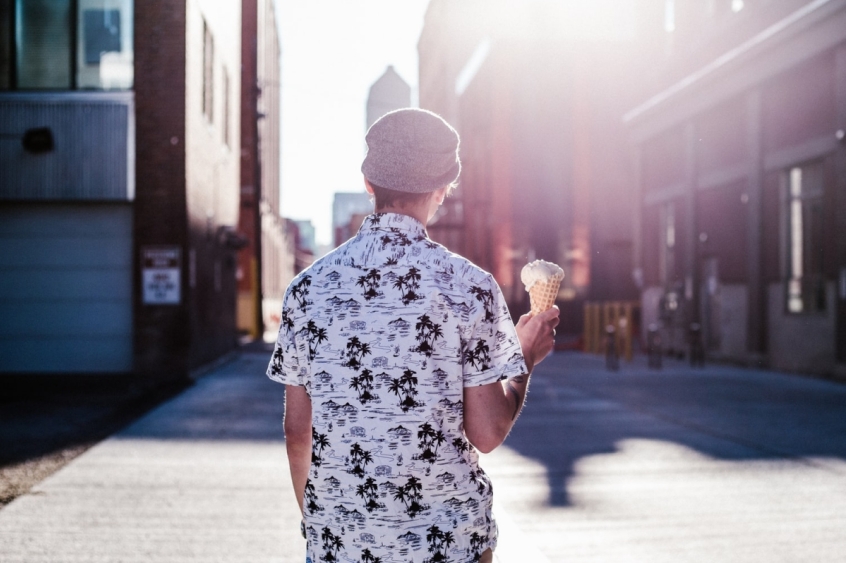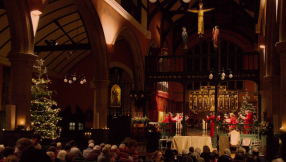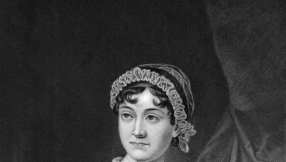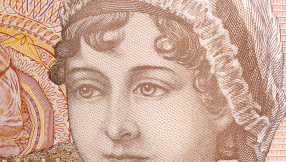
What does it mean to be a man in the 21st century? With the lines between male and female increasingly blurred, Martin Saunders attempts to answer this question in his new book, The Man You Were Meant to Be, an excerpt of which can be read below:
Sixty years ago or so, there'd have been a very clear set of assumptions about what [being a man] would have meant, and what society was expecting of you. From the moment you'd been wrapped in your blue blanket and introduced to a playroom filled with soldier figures, toy cars and little wooden play tools, your path to manhood would have been clearly marked out for you. Your identity as a male was set and defined.
There would be a set of suggested professions for you, a list of pre-approved hobbies and pastimes. Even the alcoholic drink that you'd be designated to enjoy when you reached 18(ish) was picked out for you. There would be expectations around your favourite sports (or even the idea that you enjoyed sport at all), although there might be some degree of choice there as long as you didn't pick badminton.
And perhaps most crucially, the expectations around your behaviour, and your relationship with the opposite sex, were already set. Now, there were plenty of guys born 60 years ago who rebelled against some or indeed all of those presets. Men who went into nursing, or primary school teaching, or another traditionally female-dominated profession; guys who discovered how to treat their partners with love and equality; fellas who threw themselves into needlework or netball. But they wouldn't have done so without resistance. They'd have faced mockery – and perhaps worse – for their counter-cultural choices; for not allowing themselves to be bound by gender stereotypes.
For the most part, men followed the path set out for them. Not necessarily because it was easy – imagine being a football-hating, sensitive poet growing up in a family of season-ticket-holding lumberjacks – but because it was recognized as 'true masculinity'. There was a way through growing up, which was recognized as becoming and taking on the identity of a young man.
What's followed over the past 60 years has been a mix of revolution and rebalancing. The boundaries of social expectation were first relaxed and then shifted through the decades that followed the Second World War, and then the digital revolution arrived to change everything. All through that time, questions have rightly been asked of that red meat-gnawing, emotionally stunted, power-crazed vision of masculinity. So much so, that we all now recognize it as a historical relic; a comic stereotype of a flawed version of manliness.

Say what you like about that old vision of masculinity though; at least it was clear. Growing up, men knew what was expected of them as they journeyed out of boyhood, however misguided or grotesque those expectations might have been.
Now we're not so sure. It's not clear whether we're on a journey towards a new, clear and progressive understanding of what a modern man should look like. Right now the picture is fuzzy and confused. We know so much of the old version is corrupt, but some of it doesn't feel that way, and it's not clear why that is. A more liberated, broad vision of what a man can be seems right, but are there still boundaries to that, and if so, where are they?
On New Year's Day 2019, I visited a particularly tacky gift shop on Brighton beach. My daughter, buoyed by the rare financial boom of the post-Christmas period, wanted to buy some junk for her bedroom which would doubtless get quietly recycled by about March. As we browsed, we found two matching signs designed to be hung in the houses of normal people. The first was a sign for 'Dad's Workshop', where services included 'toy mending' and 'battery replacement'.
[Incidentally, I have no problem with battery replacement being a part of the male identity. Having enough AA and AAA batteries in the drawer is a proud tradition passed through the ages, and I'm not about to suggest that it stops now. Are you sure you currently have enough? Best pick some up just to be sure.]
It was, of course, resplendently blue. Alongside it was a pink-tinged sign for 'Mum's Kitchen', where a slightly different list of activities included 'cooking', 'cleaning up after everyone' and 'applying hugs and bandages'. This was 2019 . . . and what's more, someone actually bought one of the 'mum' signs while we were browsing for overpriced laminated seashells.
For me, this was a perfect illustration of why many men experience such a confused sense of identity around what their maleness means. Yes, there are now clear progressive moves in our culture towards gender equality, where classic stereotypes are pulled apart, but there are still plenty of people who think those old stereotypes should be reinforced. So who's right? Are we meant to be chivalrous and practical, or sensitive and empowering? Or strong, resilient and brave? Or stay-at-home husbands who raise kids and write poetry? What does it mean to be a man any more, when there are loud voices in our culture advocating for so many different versions of masculinity?
Well, what if the answer to what it means to be a man wasn't defined by other people, or by the culture around us? What if instead there was a higher authority – one that we could decide to align ourselves to, instead of trying to keep pace with a highly confused world? By which I mean, what if we went back to the blueprints, and asked: what did the Creator mean for men to be like?
God created people male and female – in both cases reflecting something of himself – and while those two are different, there's an awful lot that is true of both sexes. Most fundamentally, it's that we're all handmade and unconditionally loved by the God who is still perfecting the universe, and that we're here to join in with that task. These are perhaps the most primal building blocks of our identity as men, and if we don't understand that foundation, the cracks can spread through everything else that we might layer on top.
Martin Saunders is Deputy Chief Executive Officer at Youthscape. The Man You're Made to Be is out now from SPCK Publishing, priced £7.99.

What does it mean to be a man in the 21st century? With the lines between male and female increasingly blurred, Martin Saunders attempts to answer this question in his new book, The Man You Were Meant to Be, an excerpt of which can be read below:
Sixty years ago or so, there'd have been a very clear set of assumptions about what [being a man] would have meant, and what society was expecting of you. From the moment you'd been wrapped in your blue blanket and introduced to a playroom filled with soldier figures, toy cars and little wooden play tools, your path to manhood would have been clearly marked out for you. Your identity as a male was set and defined.
There would be a set of suggested professions for you, a list of pre-approved hobbies and pastimes. Even the alcoholic drink that you'd be designated to enjoy when you reached 18(ish) was picked out for you. There would be expectations around your favourite sports (or even the idea that you enjoyed sport at all), although there might be some degree of choice there as long as you didn't pick badminton.
And perhaps most crucially, the expectations around your behaviour, and your relationship with the opposite sex, were already set. Now, there were plenty of guys born 60 years ago who rebelled against some or indeed all of those presets. Men who went into nursing, or primary school teaching, or another traditionally female-dominated profession; guys who discovered how to treat their partners with love and equality; fellas who threw themselves into needlework or netball. But they wouldn't have done so without resistance. They'd have faced mockery – and perhaps worse – for their counter-cultural choices; for not allowing themselves to be bound by gender stereotypes.
For the most part, men followed the path set out for them. Not necessarily because it was easy – imagine being a football-hating, sensitive poet growing up in a family of season-ticket-holding lumberjacks – but because it was recognized as 'true masculinity'. There was a way through growing up, which was recognized as becoming and taking on the identity of a young man.
What's followed over the past 60 years has been a mix of revolution and rebalancing. The boundaries of social expectation were first relaxed and then shifted through the decades that followed the Second World War, and then the digital revolution arrived to change everything. All through that time, questions have rightly been asked of that red meat-gnawing, emotionally stunted, power-crazed vision of masculinity. So much so, that we all now recognize it as a historical relic; a comic stereotype of a flawed version of manliness.

Growing up, men knew what was expected of them as they journeyed out of boyhood, however misguided or grotesque those expectations might have been.
Now we're not so sure. It's not clear whether we're on a journey towards a new, clear and progressive understanding of what a modern man should look like. Right now the picture is fuzzy and confused. We know so much of the old version is corrupt, but some of it doesn't feel that way, and it's not clear why that is. A more liberated, broad vision of what a man can be seems right, but are there still boundaries to that, and if so, where are they?
On New Year's Day 2019, I visited a particularly tacky gift shop on Brighton beach. My daughter, buoyed by the rare financial boom of the post-Christmas period, wanted to buy some junk for her bedroom which would doubtless get quietly recycled by about March. As we browsed, we found two matching signs designed to be hung in the houses of normal people. The first was a sign for 'Dad's Workshop', where services included 'toy mending' and 'battery replacement'.
[Incidentally, I have no problem with battery replacement being a part of the male identity. Having enough AA and AAA batteries in the drawer is a proud tradition passed through the ages, and I'm not about to suggest that it stops now. Are you sure you currently have enough? Best pick some up just to be sure.]
It was, of course, resplendently blue. Alongside it was a pink-tinged sign for 'Mum's Kitchen', where a slightly different list of activities included 'cooking', 'cleaning up after everyone' and 'applying hugs and bandages'. This was 2019 . . . and what's more, someone actually bought one of the 'mum' signs while we were browsing for overpriced laminated seashells.
For me, this was a perfect illustration of why many men experience such a confused sense of identity around what their maleness means. Yes, there are now clear progressive moves in our culture towards gender equality, where classic stereotypes are pulled apart, but there are still plenty of people who think those old stereotypes should be reinforced. So who's right? Are we meant to be chivalrous and practical, or sensitive and empowering? Or strong, resilient and brave? Or stay-at-home husbands who raise kids and write poetry? What does it mean to be a man any more, when there are loud voices in our culture advocating for so many different versions of masculinity?
Well, what if the answer to what it means to be a man wasn't defined by other people, or by the culture around us? What if instead there was a higher authority – one that we could decide to align ourselves to, instead of trying to keep pace with a highly confused world? By which I mean, what if we went back to the blueprints, and asked: what did the Creator mean for men to be like?
God created people male and female – in both cases reflecting something of himself – and while those two are different, there's an awful lot that is true of both sexes. Most fundamentally, it's that we're all handmade and unconditionally loved by the God who is still perfecting the universe, and that we're here to join in with that task. These are perhaps the most primal building blocks of our identity as men, and if we don't understand that foundation, the cracks can spread through everything else that we might layer on top.
Martin Saunders is Deputy Chief Executive Officer at Youthscape. The Man You're Made to Be is out now from SPCK Publishing, priced £7.99.













